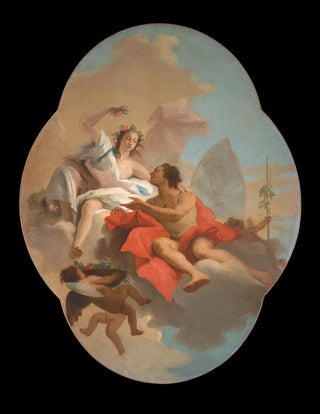Art print | Flore et Zéphyr - Giovanni Domenico Tiepolo Source: Reproduction | Flore et Zéphyr - Giovanni Domenico Tiepolo


View from behind

Frame (optional)
In the enchanting world of baroque art, the artwork "Flore et Zéphyr" by Giovanni Domenico Tiepolo stands out for its lightness and brilliance. This canvas, which evokes the encounter between the goddess of flowers and the god of wind, is a true ode to the beauty of nature and the sensuality of human relationships. Tiepolo, son of the renowned painter Giambattista Tiepolo, masterfully captures the very essence of this mythological moment, offering viewers a poetic and vibrant vision. Through this art print, we are invited to immerse ourselves in a world where dream and reality blend harmoniously.
Style and uniqueness of the artwork
The composition of "Flore et Zéphyr" is a perfect example of Tiepolo's flamboyant style. The pastel colors, delicate and luminous, create a light and airy atmosphere, while the figures, gracefully posed, seem almost to float on the canvas. The fluidity of the drapery and the expression of the faces demonstrate exceptional craftsmanship, characteristic of the artist. Flore, with her bouquet of flowers, embodies beauty and fertility, while Zéphyr, with his delicate wings, evokes movement and lightness. This interaction between the two characters is accentuated by the dynamic gestures and gazes, making the scene lively and captivating. Tiepolo manages to create a subtle balance between movement and serenity, inviting the viewer to explore every detail of this harmonious composition.
The artist and his influence
Giovanni Domenico Tiepolo, active in the 18th century, is often regarded as one of the greatest masters of his time. Son of Giambattista Tiepolo, he inherited a rich artistic legacy while developing his own unique style. His work is characterized by a keen sense of color and exceptional mastery of light, allowing him to create enchanting atmospheres. Tiepolo was also influenced by the great masters of the Renaissance, integrating classical elements into his compositions. His ability to tell stories through painting has left a lasting mark on the art world.

Matte finish

View from behind

Frame (optional)
In the enchanting world of baroque art, the artwork "Flore et Zéphyr" by Giovanni Domenico Tiepolo stands out for its lightness and brilliance. This canvas, which evokes the encounter between the goddess of flowers and the god of wind, is a true ode to the beauty of nature and the sensuality of human relationships. Tiepolo, son of the renowned painter Giambattista Tiepolo, masterfully captures the very essence of this mythological moment, offering viewers a poetic and vibrant vision. Through this art print, we are invited to immerse ourselves in a world where dream and reality blend harmoniously.
Style and uniqueness of the artwork
The composition of "Flore et Zéphyr" is a perfect example of Tiepolo's flamboyant style. The pastel colors, delicate and luminous, create a light and airy atmosphere, while the figures, gracefully posed, seem almost to float on the canvas. The fluidity of the drapery and the expression of the faces demonstrate exceptional craftsmanship, characteristic of the artist. Flore, with her bouquet of flowers, embodies beauty and fertility, while Zéphyr, with his delicate wings, evokes movement and lightness. This interaction between the two characters is accentuated by the dynamic gestures and gazes, making the scene lively and captivating. Tiepolo manages to create a subtle balance between movement and serenity, inviting the viewer to explore every detail of this harmonious composition.
The artist and his influence
Giovanni Domenico Tiepolo, active in the 18th century, is often regarded as one of the greatest masters of his time. Son of Giambattista Tiepolo, he inherited a rich artistic legacy while developing his own unique style. His work is characterized by a keen sense of color and exceptional mastery of light, allowing him to create enchanting atmospheres. Tiepolo was also influenced by the great masters of the Renaissance, integrating classical elements into his compositions. His ability to tell stories through painting has left a lasting mark on the art world.






